Overview
This article offers valuable examples and guidance for crafting effective lay statements that can significantly strengthen VA disability claims. We understand that navigating this process can be challenging, and personal narratives play a crucial role in conveying the daily struggles veterans face. By detailing how their conditions impact their lives, veterans can create a compelling case that resonates with decision-makers.
It's common to feel overwhelmed when trying to articulate these experiences. However, incorporating specific observations and relationships can enhance the credibility of these statements. This not only increases the likelihood of claim approval but also helps to paint a vivid picture of the veteran's reality.
Remember, you are not alone in this journey. We're here to help you share your story in a way that truly reflects your experiences. By focusing on the details of your daily challenges, you can make a powerful impact on your claim.
As you prepare your lay statement, consider these key points:
- Share personal anecdotes that illustrate your struggles.
- Use clear, concise language to describe your experiences.
- Reflect on how your condition affects your relationships and daily activities.
By following these steps, you can create a narrative that not only supports your claim but also honors your journey. Together, we can work towards ensuring that your voice is heard and your needs are met.
Introduction
Navigating the VA disability claims process can feel overwhelming for veterans seeking the benefits they truly deserve. We understand that this journey is filled with challenges and uncertainties. That’s why it’s essential to recognize the significance of lay statements. These personal narratives offer a unique glimpse into how disabilities affect daily life, making them a vital part of your claim.
In this article, we’ll explore ten compelling examples of effective VA lay statements. Our goal is to equip you with the tools you need to share your experiences and strengthen your claims. But what truly makes a lay statement resonate with decision-makers? How can you ensure your voice is heard amidst the complexities of the claims process?
You are not alone in this journey. Together, we can navigate these challenges and advocate for the benefits you deserve.
Turnout: AI-Powered Advocacy for VA Disability Claims
Navigating the complexities of disability requests and tax debt assistance can be overwhelming for former service members. At Turnout, we understand these challenges, and that’s why we’ve developed an AI-driven platform designed to provide prompt and effective support in your pursuit of benefits.
Our advanced technology ensures that you receive the assistance you deserve. Meet Jake, our AI system that efficiently manages case details, deadlines, and communication. This allows advocates to focus on what truly matters: offering you strategic guidance and personalized support.
This modern approach not only speeds up the request process but also enhances your overall experience. Many former service members have shared that being actively engaged in their application process, with the help of AI, leads to better outcomes. With skilled non-legal advocates by your side, you can feel confident that your submissions are well-supported, ensuring you receive the benefits you’re entitled to.
Moreover, our AI significantly reduces wait times by accelerating application processing. This helps tackle the backlog of pending requests, allowing us to focus on more complex cases. Did you know that initial disability requests typically take 90-140 days to process? That’s why the efficiency of Turnout's AI system is such a vital resource in navigating the often daunting bureaucratic landscape.
It’s important to remember that if you don’t actively engage in your claims process, you may face significant hurdles in obtaining the benefits you need. But you’re not alone in this journey. We’re here to help you every step of the way.
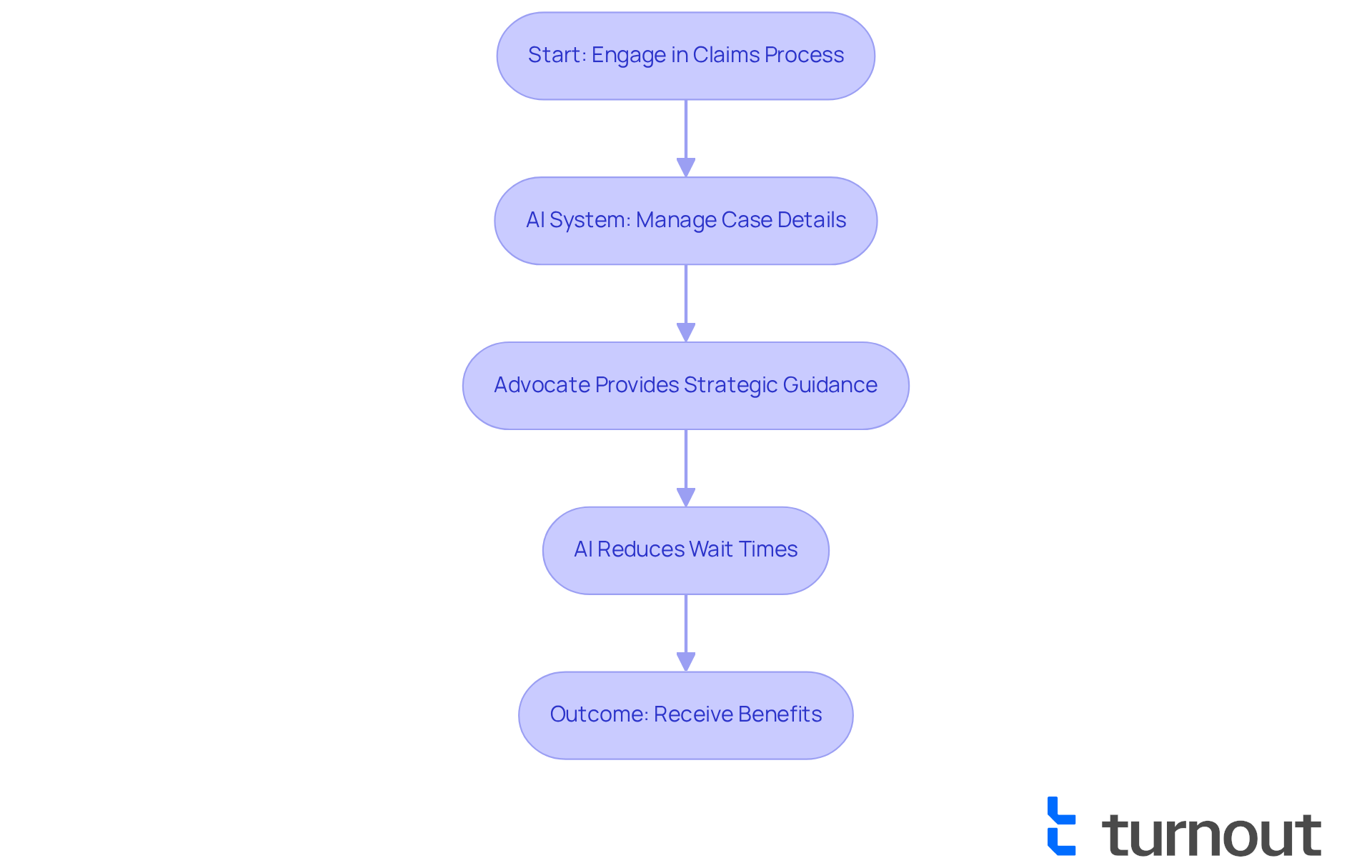
Understanding Lay Statements: Essential Components for VA Claims
Personal narratives offer invaluable insights into the experiences of former service members and how their conditions affect daily life. If you're looking to craft an effective lay statement, consider these essential components:
- Relationship to the Veteran: Start by clearly stating how you know the veteran. This establishes credibility and context.
- Specific Observations: Share specific instances that highlight the individual's limitations, like challenges in daily tasks or noticeable changes in behavior.
- Impact on Daily Activities: Describe how the disability affects the individual's routine, social interactions, and overall quality of life.
These elements serve as persuasive proof to support your arguments. It’s vital for veterans to understand how to articulate these points effectively. Current guidelines emphasize clarity and detail, ensuring that your message resonates with decision-makers. For instance, the VA's service-connection criterion is 'at least as likely as not' (50/50), underscoring the importance of strong personal accounts in supporting claims. As VA disability expert Brian Reese points out, "You must clearly link your current disability to service with complete and consistent evidence."
Effective VA lay statement examples often highlight personal stories that connect the individual's experiences with their service-related disabilities, providing deeper insight into their challenges. We encourage veterans to review their documents with a trusted individual or advocate before submission. This step can ensure clarity and completeness, making your narrative even more compelling.
Remember, you are not alone in this journey. We're here to help you navigate these challenges.
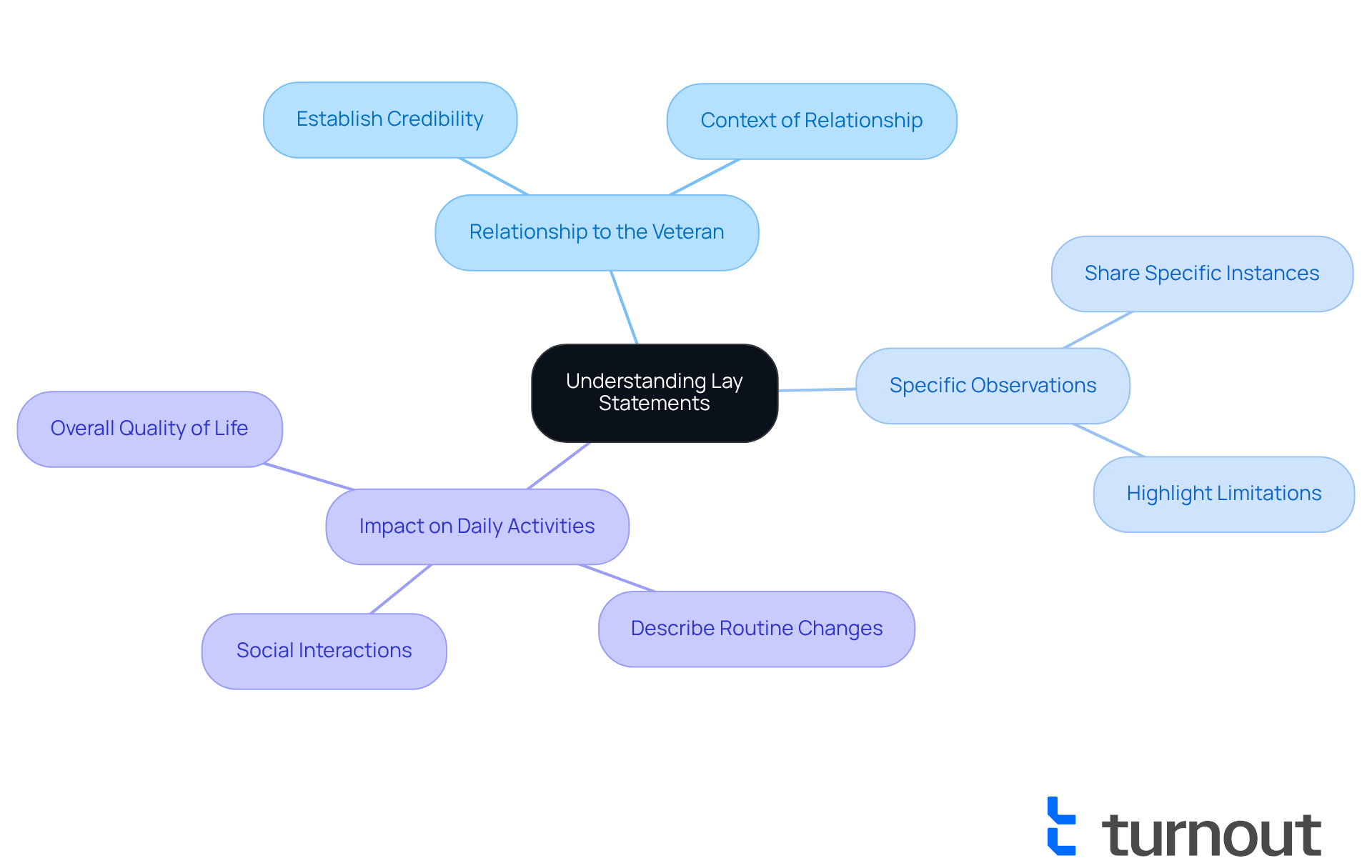
Real-Life Examples of Effective Lay Statements for VA Disability Claims
-
Example from a Spouse: "I have witnessed my husband struggle with daily tasks since his deployment. He often forgets to take his medication and has difficulty concentrating, which affects his ability to manage our household. This has led to increased stress in our family life, as I often have to remind him of essential tasks."
-
Example from a Friend: "As a close friend of the veteran, I have seen how his PTSD affects his social interactions. He avoids gatherings and often experiences anxiety attacks in crowded places, which has caused him to withdraw from friends and family. This isolation has taken a toll on his mental health and our friendship."
-
Example from a Family Member: "My sister's mobility has significantly declined since her injury. She requires assistance with basic activities like bathing and dressing, which she used to do independently. Her condition has not only affected her physical capabilities but also her emotional well-being, as she feels frustrated and dependent on others."
These examples emphasize the importance of specificity and personal observation in informal remarks, such as a VA lay statement example. We understand that sharing these experiences can be challenging, but it’s essential that all VA lay statement examples are signed and dated to confirm their truthfulness and enhance their credibility. Statistics show that requests backed by thorough lay statements have a greater likelihood of approval, with around 50% of Supplemental Requests succeeding when new and pertinent evidence is provided. Personal narratives like these can serve as a VA lay statement example, offering the VA a clearer insight into the individual's daily challenges and making them an essential element of a successful disability request.
Veterans are encouraged to discuss their requests with accredited representatives or Veterans Service Organizations (VSOs) for additional support. Remember, the eligibility of who can write a buddy letter depends on the veteran's needs and the writer's personal knowledge of the veteran's service or conditions. You are not alone in this journey; we’re here to help.

How to Obtain Lay Statements: A Step-by-Step Guide
-
Identify Potential Writers: We understand that reaching out can feel daunting. Consider connecting with family members, friends, or colleagues who can share their observations about your condition and how it affects your daily life. Their insights can be invaluable.
-
Clarify the Objective: It's important to convey to prospective authors just how significant their contributions are. Highlight how their perspectives can strengthen your argument and support your case. This can make a real difference.
-
Provide Guidance: Share examples and key points that should be included in their narratives. Consider specific instances as a VA lay statement example where your disability impacts daily activities, work, and relationships. Including details about your symptoms and their effects is crucial for the VA lay statement example assessment.
-
Establish a Deadline: To keep things moving smoothly, encourage writers to submit their accounts by a specific date. This helps ensure that the claims process doesn’t get delayed.
-
Review and Edit: Once you receive the documents, take the time to review them for clarity and completeness. Make sure they effectively convey the necessary information before submission. Remember, being honest about your symptoms is essential for maintaining credibility with the VA. Downplaying symptoms can lead to inaccurate ratings or even denial of service connection. Also, consider using VA Form 21-10210, the recommended form for submitting personal accounts, to ensure proper processing. Utilizing the Fully Developed Claims program can help expedite the decision-making process by allowing you to submit all available evidence.
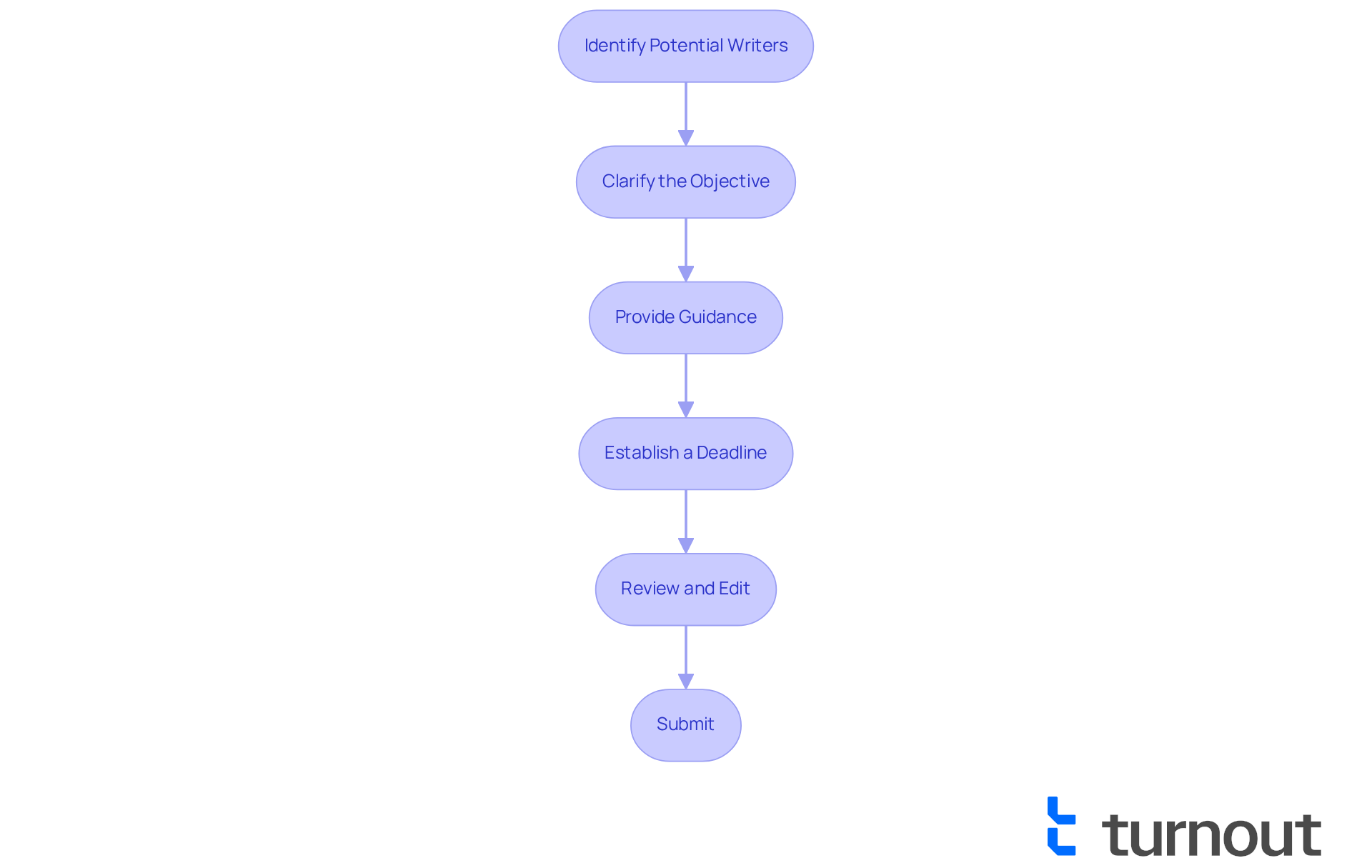
Writing Effective Lay Statements: Tips and Best Practices
-
Be Specific: We understand that sharing your experiences can be challenging. It’s important to provide a VA lay statement example that clearly describes how your limitations affect daily life. For example, instead of saying, "I have trouble walking," you might say, "I can only walk for 10 minutes before needing to rest due to severe pain in my knees." This level of detail serves as a VA lay statement example that helps the VA truly grasp the extent of your disability.
-
Stay Objective: It’s common to feel overwhelmed by emotions, but focusing on observable facts can strengthen your case. Instead of stating, "I often feel sad," consider sharing specific examples, like, "Since my injury, I have missed family gatherings and social events, which has affected my mood and relationships." This approach enhances the reliability of your assertions.
-
Use Clear Language: We want to ensure your message is understood. Avoid technical jargon and use simple, everyday language to describe your experiences. For instance, instead of saying, "I experience significant mobility impairment," you could say, "I struggle to move around my home without assistance." This clarity makes your assertions more accessible to reviewers.
-
Include dates and context: A VA lay statement example can provide context that is incredibly powerful. Reference specific incidents or timeframes to illustrate your observations. For example, "On July 15, 2023, I fell while trying to get out of bed, which resulted in a hospital visit." This adds weight to your claim by showing the impact of your disability over time. As Claims Advocate Amy Mallette highlights, "Your account enables you to vividly depict the event, its effects on you, and the immediate aftermath, offering a personal perspective that other documents can’t."
-
Proofread: Taking the time to carefully check for grammatical errors and clarity is crucial. A well-crafted declaration showcases your professionalism and attention to detail. Consider having someone else review your document to ensure it’s clear and understandable. This step can greatly enhance its effectiveness, ensuring that your message is conveyed clearly and without errors.

Submitting Lay Statements: Key Steps to Ensure Acceptance
-
Compile All Records: We understand that gathering documents can feel overwhelming. Start by collecting all lay declarations along with any supporting documents, such as a va lay statement example you have. This step is crucial in ensuring your voice is heard.
-
Follow VA Guidelines: It’s important to ensure that your declarations, including a va lay statement example, meet the VA's formatting and content requirements. This can help avoid delays and make the process smoother for you.
-
Submit with the Request: When you submit your request, include the narrative details as part of your initial submission or as supplementary evidence if necessary. This helps paint a complete picture of your situation.
-
Keep Copies: Remember to retain copies of all submitted documents for your personal records. This way, you’ll have everything on hand if you need to reference it later.
-
Track Submission: We encourage you to utilize the VA's online resources to monitor the status of your request and verify receipt of your documents. Staying informed can ease some of the anxiety that comes with waiting.

Limitations of Lay Evidence: What Claimants Need to Know
Navigating the VA disability process can be challenging, and we understand that personal accounts can be valuable resources in supporting your requests. However, it’s important to recognize that these accounts come with certain limitations. The VA often requires supporting documentation to validate your claims, as non-expert evidence may not carry the same weight as medical records. In fact, claims that rely solely on non-professional statements face significant rejection rates—some reports indicate that up to 80% of these claims are undervalued or denied. This underscores the need for detailed and specific statements, as vague or generalized remarks are less likely to sway decisions in your favor.
Expert opinions emphasize the critical role of medical evidence in the evaluation process. A genuine diagnosis from a board-certified physician is essential, as it lays the groundwork for any claim. Ideally, a VA lay statement example should complement medical records, filling in gaps where documentation may be lacking. This combination enhances the overall credibility of your assertion, as the VA lay statement example is more likely to support applications that present a well-rounded case, backed by both lay and medical evidence.
As a veteran, it’s crucial to understand that while lay evidence holds value, it shines brightest when supported by thorough medical documentation. This approach not only strengthens your claim but also aligns with the VA's standards for credible evidence. As VA disability benefits expert Brian Reese wisely notes, 'Submitting a VA lay statement example with your VA disability submission is a strategic move, particularly when medical evidence is lacking or incomplete.'
Remember, you are not alone in this journey. We're here to help you navigate these complexities and ensure your voice is heard.
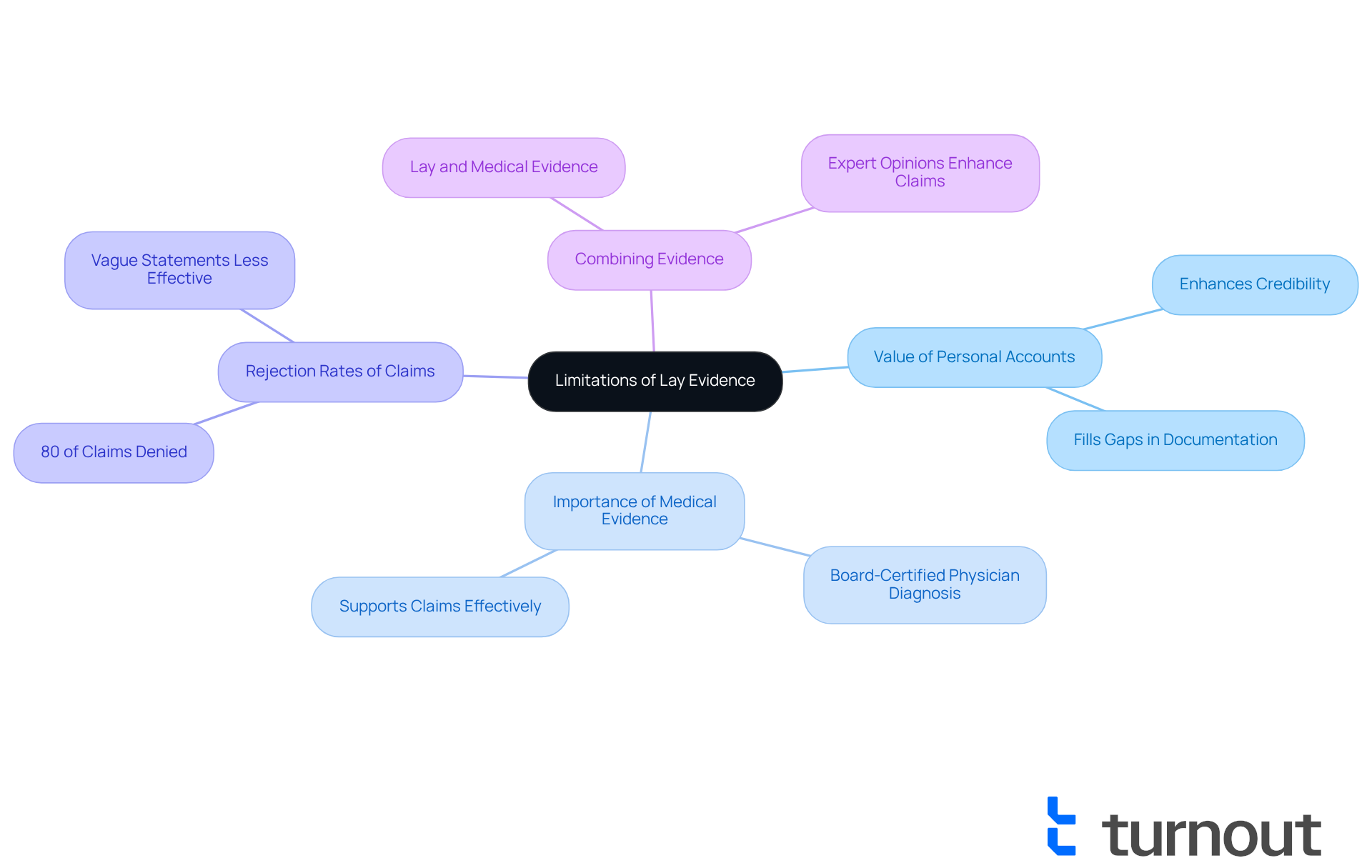
When to Use Expert Evidence in VA Disability Claims
Expert testimony plays a vital role when non-expert assertions may not fully support a case. We understand that navigating the complexities of the VA can be overwhelming, especially in situations involving intricate medical conditions or when detailed explanations of how a disability affects daily life are required. Expert insights provide the essential context and verification that non-expert remarks often lack, making them a crucial part of a strong argument strategy.
Consider this: requests backed by Independent Medical Opinions (IMOs) have shown a remarkable increase in approval rates. Statistics reveal that submissions supported by expert evidence boast a success rate of about 74.9%, compared to just 36% for those relying solely on a VA lay statement example. This clearly illustrates how expert evidence can transform a subjective narrative into a compelling, evidence-supported argument.
Veterans who actively seek expert insights, such as nexus letters from qualified professionals, often find that their requests are not only more credible but also processed more efficiently. Many experience quicker resolution periods, which can be a relief during this challenging time.
It's common to feel uncertain about the VA benefits process, but remember, you are not alone in this journey. Professional insights are key to navigating the intricacies of obtaining the support you deserve. We're here to help you every step of the way.
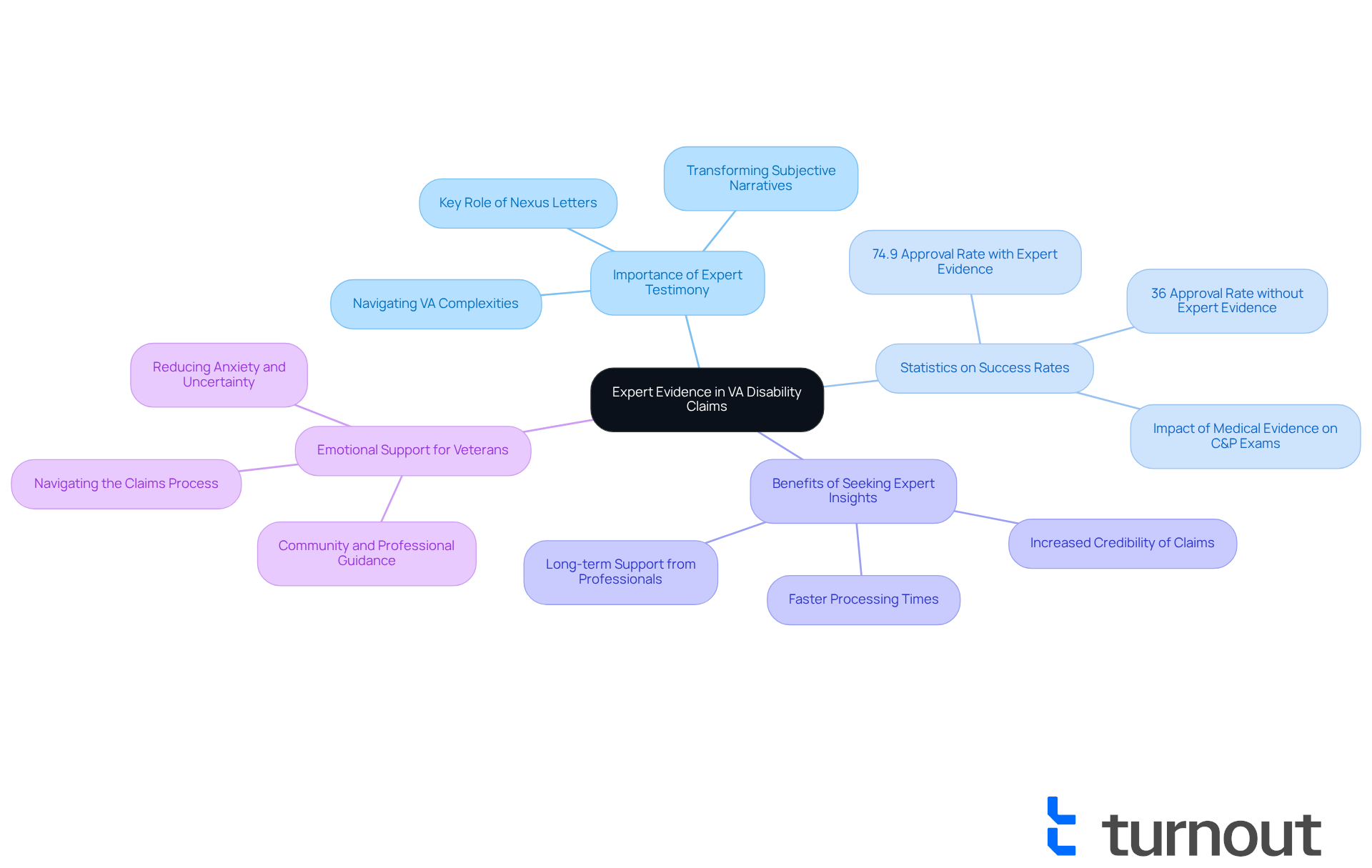
The Role of Personal Statements in Supporting VA Claims
Personal narratives created by former service members are crucial in the claims process. They allow veterans to share their unique experiences, challenges, and the profound effects of their disabilities on daily life. By telling their stories, veterans can connect with decision-makers at the VA, increasing the chances of a favorable outcome.
To make these statements as effective as possible, it’s essential for veterans to be honest and detailed. Specific examples of how disabilities impact their quality of life can significantly bolster their claims. For instance, describing when symptoms began, how they have progressed, and the limitations they cause can provide context that medical records alone might miss. It’s important to avoid vague language and unsupported claims, focusing instead on concrete incidents that illustrate their struggles.
Research shows that personal narratives can greatly influence the success of disability applications. Veterans who effectively share their experiences often find that their stories fill in gaps in medical documentation, offering a fuller picture of their conditions. This narrative approach not only personalizes the claim but also aligns with the VA's emphasis on understanding each individual's lived experience.
Incorporating emotional elements and storytelling techniques can further engage the reader, making the message more relatable and impactful. Seeking feedback on personal narratives can also help veterans refine their submissions, ensuring clarity and effectiveness.
Ultimately, a well-crafted personal statement, such as a VA lay statement example, can be a decisive factor in securing VA benefits, especially when paired with strong medical evidence. Veterans should view this as an opportunity to advocate for themselves, ensuring their voices are heard and their experiences acknowledged throughout the process.
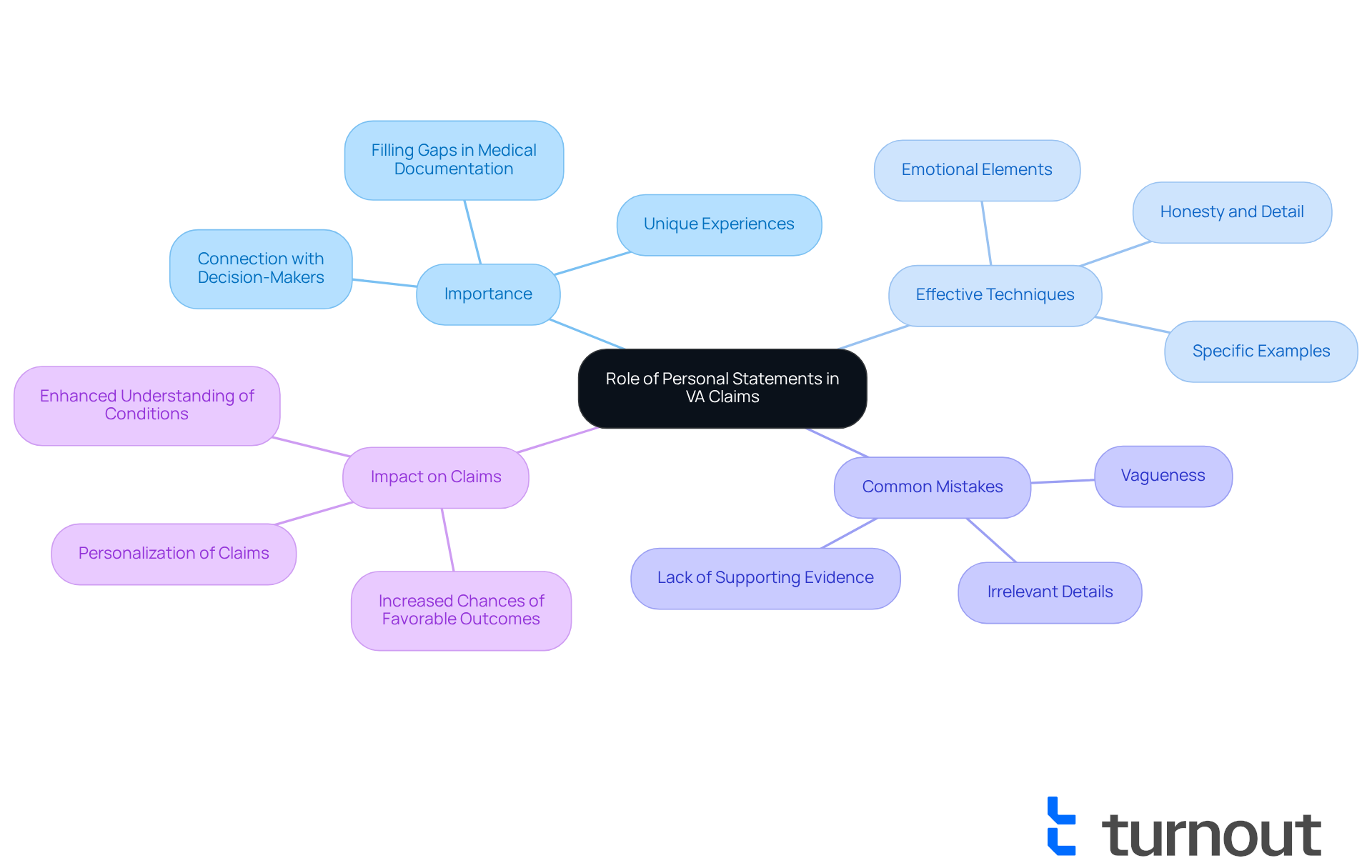
The Importance of Lay Evidence in Strengthening VA Disability Claims
Lay evidence plays a vital role in VA disability applications, offering personal insights that medical records alone often miss. It helps paint a fuller picture of the daily challenges veterans face and the real impacts of their disabilities. By effectively using a VA lay statement example, veterans can significantly enhance their submissions. It’s essential for them to understand how to gather, write, and present this type of evidence. When combined with medical documentation, lay evidence creates a strong case that can lead to successful outcomes.
Veterans who include a VA lay statement example frequently see better ratings and approvals for benefits. This type of evidence can help secure a higher disability rating or approval for Total Disability Individual Unemployability (TDIU) benefits. It can describe service-related incidents, illustrate the daily effects of a condition, and support medical evidence, thereby boosting the overall credibility of the claim.
There’s no limit to how much lay evidence can be submitted. If the VA dismisses lay evidence, they must explain why it’s not credible. This highlights the importance of submitting thorough documentation that backs up the case, especially when medical records are incomplete or unavailable. Many veterans have successfully raised their disability ratings or obtained TDIU benefits by including lay evidence that underscores the severity of their conditions.
Effective VA lay statement examples can come from family members, friends, co-workers, or supervisors, confirming observed symptoms and behaviors. These statements are particularly valuable for conditions like PTSD, where personal accounts can reveal the deep impact on daily life. Veterans are encouraged to seek guidance on crafting these documents, ensuring they are detailed and relevant. Using VA Form 21-4138 for submission can help ensure proper processing by the VA.
In conclusion, gathering and submitting lay evidence is crucial for strengthening VA disability claims. We encourage veterans to start collecting their statements to improve their chances of securing the benefits they deserve. Remember, you are not alone in this journey; we’re here to help.

Conclusion
Navigating the VA disability claims process can feel overwhelming. We understand that veterans face numerous challenges in seeking the benefits they deserve. That’s why it’s crucial to recognize the importance of lay statements. These personal narratives are powerful tools that provide insights into the daily struggles veterans endure and how their disabilities affect their lives. By crafting and submitting effective lay statements, veterans can significantly strengthen their claims and improve their chances of approval.
This article highlights essential components for writing impactful lay statements:
- Start by establishing your relationship to the veteran.
- Provide specific observations and describe how the disability impacts daily activities.
- Real-life examples show the value of detailed, personal accounts in supporting claims.
- Remember, combining lay evidence with medical documentation enhances the credibility of your claims.
We encourage veterans to actively engage in their claims process. Utilize the insights and strategies outlined here. Gathering comprehensive lay statements and seeking assistance from advocates can make navigating the complexities of the VA system more manageable. The journey may be challenging, but with the right support and resources, securing the benefits you deserve is within reach. You are not alone in this journey; we’re here to help.
Frequently Asked Questions
What is Turnout and how does it assist former service members?
Turnout is an AI-driven platform designed to provide support for former service members navigating disability requests and tax debt assistance. It offers prompt and effective help by managing case details, deadlines, and communication, allowing advocates to focus on providing strategic guidance and personalized support.
How does the AI system at Turnout improve the claims process?
The AI system at Turnout, named Jake, speeds up the request process, reduces wait times, and enhances the overall experience for users. It helps tackle the backlog of pending requests and allows advocates to concentrate on more complex cases, ultimately leading to better outcomes for former service members.
What is the typical processing time for initial disability requests?
Initial disability requests typically take 90-140 days to process.
What are lay statements and why are they important for VA claims?
Lay statements are personal narratives that provide insights into how a veteran's condition affects their daily life. They are important because they serve as persuasive proof to support disability claims, highlighting specific observations and the impact of the disability on the individual's routine and quality of life.
What essential components should be included in an effective lay statement?
An effective lay statement should include the relationship to the veteran, specific observations of their limitations, and the impact of the disability on their daily activities.
Can you provide examples of effective lay statements?
Yes, examples include: - A spouse describing how a veteran struggles with daily tasks and medication management. - A friend noting how PTSD affects a veteran's social interactions and leads to isolation. - A family member explaining how a veteran's mobility issues require assistance with basic activities.
What is the significance of signing and dating lay statements?
Signing and dating lay statements confirm their truthfulness and enhance their credibility, making them more effective in supporting disability requests.
How can veterans ensure their lay statements are compelling?
Veterans are encouraged to review their documents with a trusted individual or advocate before submission to ensure clarity and completeness, which can make their narrative more persuasive.
Who can write a buddy letter for a veteran's claim?
The eligibility of who can write a buddy letter depends on the veteran's needs and the writer's personal knowledge of the veteran's service or conditions.
What support options are available for veterans navigating the claims process?
Veterans can discuss their requests with accredited representatives or Veterans Service Organizations (VSOs) for additional support throughout the claims process.




